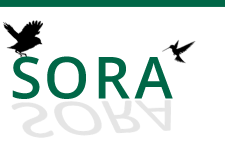Abstract
La Polla de Wetmore Rallus wetmorei es una especie endémica de Venezuela con distribución restringida, características que han hecho que se la catalogue En Peligro. La distribución de la Polla de Wetmore es disyunta, por lo que existe la posibilidad de que la especie esté constituida por poblaciones pequeñas y aisladas, restringidas a las distintas formaciones de mangle en la costa noroccidental del país. Para evaluar la diversidad y estructura genética de la Polla de Wetmore, empleamos muestras de 19 individuos de cuatro localidades a lo largo de su rango de distribución geográfi ca. Luego de amplifi car y secuenciar un gen mitocondrial, la subunidad 2 de la NADH deshidrogenasa (ND2), y un gen nuclear, el intrón 5 de la alcohol deshidrogenasa I (ADH5), se identifi caron 9 haplotipos para el gen ND2 y sólo uno para ADH5. La diversidad haplotípica obtenida para la especie con el gen mitocondrial fue de 0,819, mientras que la nucleotídica fue 0,0062. Los valores obtenidos de Fst y los resultados del Análisis de Varianza Molecular (AMOVA) indican que no existe estructura genética y sugieren que existe fl ujo genético entre las poblaciones estudiadas. Adicionalmente, los resultados de la distribución de diferencias pareadas parecen indicar que el tamaño poblacional de la especie ha sido relativamente constante a lo largo del tiempo.
The Plain-fl anked Rail Rallus wetmorei is an endemic species from Venezuela, with restricted distribution, and because of these characteristics is categorized as Endangered. The Plain-fl anked Rail has a disjunct distribution, thus, there is a good chance that this species is constituted by small and isolated populations restricted to the northwestern coast of the country. To assess the genetic diversity and structure of the Plain-fl anked Rail, we used samples from 19 individuals from four localities within its geographic distributional range. After the amplifi cation and secuencing of one mitochondrial gene, the NADH dehydrogenase subunit 2 (ND2), and one nuclear gene, the intron 5 from the alcohol dehydrogenase-I (ADH5), we identifi ed 9 haplotypes for the gene ND2 and only one for ADH5. The haplotype diversity for this species based on the mitochondrial gene was 0.819, whereas the nucleotide diversity was 0.0062. Fst values and the results of the Analysis of Molecular Variance (AMOVA) indicated that there is no genetic structure and suggest the existence of gene fl ow among the studied populations. Additionally, results from the mismatch distribution seem to indicate that population size of the species has been relatively constant over time.
Creative Commons License
Recommended Citation
Barrios, Adriana C. Rojas and Rodríguez-Ferraro, Adriana
(2015)
"Diversidad y estructura genética de la Polla de Wetmore Rallus wetmorei Zimmer y Phelps 1944 (Aves: Rallidae) / Genetic Diversity and Structure of the Plain-Flanked Rail Rallus wetmorei Zimmer y Phelps 1944 (Aves: Rallidae),"
Revista Venezolana de Ornitología: Vol. 5
:
Iss.
1
, Article 9.
Available at:
https://digitalcommons.usf.edu/rvo/vol5/iss1/9

